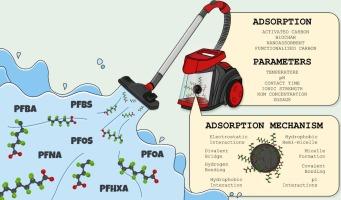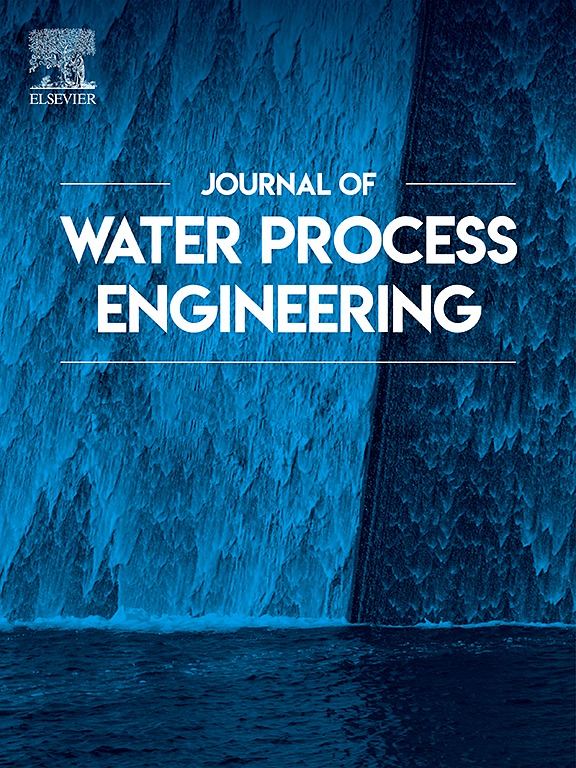利用碳基吸附剂去除多氟和全氟化物:全面综述
IF 6.3
2区 工程技术
Q1 ENGINEERING, CHEMICAL
引用次数: 0
摘要
聚全氟烷基和全氟烷基化合物 (PFAS) 是一种合成的高氟化学物质,常用于防水材料、个人护理用品、不粘锅和清洁剂等产品中。由于其 CF 键的强度,PFAS 在环境中的持久性极强,给污染控制带来了巨大挑战。传统的降解方法往往效果不佳,因此吸附技术成为去除受污染水体中 PFAS 的理想替代方法。碳基吸附剂因其可持续性和高效性而备受推崇,在这方面尤为有效。本综述详细分析了各种碳基吸附剂(包括活性炭、生物炭、氧化石墨烯、碳纳米管和磁性复合材料)的 PFAS 特性及其去除效果。这些材料的吸附容量差异很大,Fe3O4-杂化生物炭的吸附容量低至 10.7 mg/g,而功能化石墨烯基吸附剂的吸附容量则高达 713.85 mg/g,这表明与传统的生物炭和活性炭相比,改性石墨烯吸附剂具有更高的吸附效率。这些吸附剂大多符合朗缪尔等温线模型和假二阶动力学模型,且测定系数较高,表明它们具有高效的单层吸附能力以及与全氟辛烷磺酸的强相互作用。综述还探讨了不同的吸附机理、工艺参数对吸附效率的影响、吸附剂再生策略,并在最后通过文献计量分析强调了主要的研究空白。这些见解旨在指导未来利用碳基吸附剂开发有效、可扩展的 PFAS 修复技术。本文章由计算机程序翻译,如有差异,请以英文原文为准。

Harnessing carbon-based adsorbents for poly- and perfluorinated substance removal: A comprehensive review
Poly- and perfluoroalkyl substances (PFAS) are synthetic, highly fluorinated chemicals commonly used in products like water-resistant materials, personal care items, non-stick cookware, and cleaning agents. Due to the strength of their C![]() F bonds, PFAS are extremely persistent in the environment, creating significant challenges for pollution control. Traditional degradation methods often prove ineffective, making adsorption a promising alternative for PFAS removal from contaminated water. Carbon-based adsorbents, valued for their sustainability and efficiency, are particularly effective for this purpose. This review provides a detailed analysis on PFAS properties and their removal using various carbon-based adsorbents, including activated carbon, biochar, graphene oxide, carbon nanotubes, and magnetic composites. Adsorption capacities of these materials were seen vary significantly, from as low as 10.7 mg/g for Fe3O4-hybrid biochar, to as high as 713.85 mg/g for functionalized graphene-based adsorbent, highlighting the superior adsorption efficiency of modified graphene adsorbents compared to traditional biochar and activated carbons. Most of these adsorbents fit the Langmuir isotherm model and pseudo-second-order kinetic model with high coefficient of determination, indicating efficient monolayer adsorption and strong interaction with PFAS. The review also explores different adsorption mechanisms, the effects of process parameters on adsorption efficiency, strategies for adsorbent regeneration, and concludes with a bibliometric analysis that highlights key research gaps. These insights are intended to guide future advancements in the development of effective, scalable PFAS remediation technologies using carbon-based adsorbents.
F bonds, PFAS are extremely persistent in the environment, creating significant challenges for pollution control. Traditional degradation methods often prove ineffective, making adsorption a promising alternative for PFAS removal from contaminated water. Carbon-based adsorbents, valued for their sustainability and efficiency, are particularly effective for this purpose. This review provides a detailed analysis on PFAS properties and their removal using various carbon-based adsorbents, including activated carbon, biochar, graphene oxide, carbon nanotubes, and magnetic composites. Adsorption capacities of these materials were seen vary significantly, from as low as 10.7 mg/g for Fe3O4-hybrid biochar, to as high as 713.85 mg/g for functionalized graphene-based adsorbent, highlighting the superior adsorption efficiency of modified graphene adsorbents compared to traditional biochar and activated carbons. Most of these adsorbents fit the Langmuir isotherm model and pseudo-second-order kinetic model with high coefficient of determination, indicating efficient monolayer adsorption and strong interaction with PFAS. The review also explores different adsorption mechanisms, the effects of process parameters on adsorption efficiency, strategies for adsorbent regeneration, and concludes with a bibliometric analysis that highlights key research gaps. These insights are intended to guide future advancements in the development of effective, scalable PFAS remediation technologies using carbon-based adsorbents.
求助全文
通过发布文献求助,成功后即可免费获取论文全文。
去求助
来源期刊

Journal of water process engineering
Biochemistry, Genetics and Molecular Biology-Biotechnology
CiteScore
10.70
自引率
8.60%
发文量
846
审稿时长
24 days
期刊介绍:
The Journal of Water Process Engineering aims to publish refereed, high-quality research papers with significant novelty and impact in all areas of the engineering of water and wastewater processing . Papers on advanced and novel treatment processes and technologies are particularly welcome. The Journal considers papers in areas such as nanotechnology and biotechnology applications in water, novel oxidation and separation processes, membrane processes (except those for desalination) , catalytic processes for the removal of water contaminants, sustainable processes, water reuse and recycling, water use and wastewater minimization, integrated/hybrid technology, process modeling of water treatment and novel treatment processes. Submissions on the subject of adsorbents, including standard measurements of adsorption kinetics and equilibrium will only be considered if there is a genuine case for novelty and contribution, for example highly novel, sustainable adsorbents and their use: papers on activated carbon-type materials derived from natural matter, or surfactant-modified clays and related minerals, would not fulfil this criterion. The Journal particularly welcomes contributions involving environmentally, economically and socially sustainable technology for water treatment, including those which are energy-efficient, with minimal or no chemical consumption, and capable of water recycling and reuse that minimizes the direct disposal of wastewater to the aquatic environment. Papers that describe novel ideas for solving issues related to water quality and availability are also welcome, as are those that show the transfer of techniques from other disciplines. The Journal will consider papers dealing with processes for various water matrices including drinking water (except desalination), domestic, urban and industrial wastewaters, in addition to their residues. It is expected that the journal will be of particular relevance to chemical and process engineers working in the field. The Journal welcomes Full Text papers, Short Communications, State-of-the-Art Reviews and Letters to Editors and Case Studies
 求助内容:
求助内容: 应助结果提醒方式:
应助结果提醒方式:


